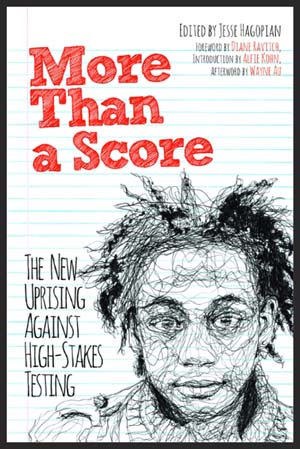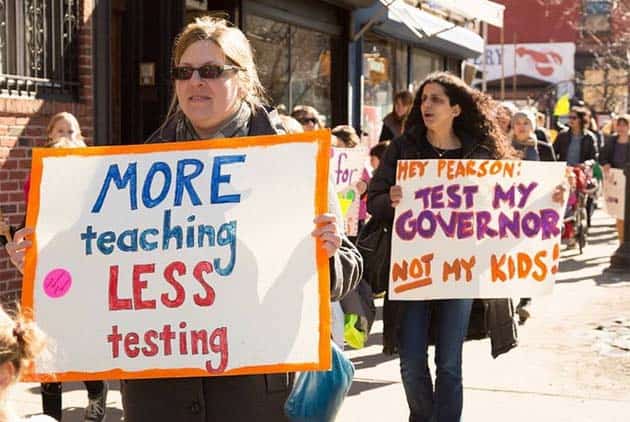Lucy Honan looks at a new book on the growing rebellion against standardised testing and the cuts to public education in the US
More than a Score is a jolt of teacher activist energy. These are proud battle stories, directly from the leaders of the greatest movement against high stakes testing in American history.
For teachers sick to death of NAPLAN, nothing is better for the soul than reading about the tens of thousands taking part in boycotts, bans and demonstrations against standardised tests.
At the heart of their campaign is a battle to wrestle control of education out of the hands of neo-liberal ideologues and corporate reformers, and to return it to the teachers and the community. If they can do it, so can we.
“I’m not going to give the MAP test (A Seattle version of NAPLAN)… and there are others I have talked to as well.” Teacher Mallory Clarke defiantly whispered these words to her fellow teacher and school union rep after work in early January, 2013.
Within weeks, Jesse Hagopian (the union rep who went on to edit of More than a Score), Mallory Clarke and a core of strong anti-testing teachers organised a vote of the entire teaching staff at Garfield High to refuse to give the MAP.
The Garfield Parent Teacher Association publicly pledged their full support, three other Seattle schools joined the boycott, followed by more in the Spring. Teachers from around the world (inlcuding me!) were flooding the school with messages of solidarity and congratulations.
The teachers were organising press conferences, city wide boycott co-ordinating councils, rallies, writing op-eds and meetings with parents.
The Garfield teachers called a national day of action to support Seattle’s boycott. The NAACP and the Portland Student Union both held press conferences in solidarity, teachers in California held a rally, and in Chicago a parent group called “More than a score” began a petition to get students in 30 schools opted out of their standardised tests. The presidents of the two major teachers’ unions in the US sent letters of support.
The boycotting teachers stood firm when the superintendent threatened ten day suspensions for refusing to administer the test.
When the principals decided they would administer the tests themselves, senior students at Garfield wrote a leaflet on why students should not sit the test and distributed them to younger students before school. The kids whose parents had not opted them out performed classroom “sit-ins”, refusing to leave their lessons to take part in the tests.
In May, Garfield declared victory. The Seattle superintendent backed down and declared the MAP tests “optional” for high schools the following year. But the movement to uproot standardised tests altogether had only just begun—hardly a week goes by without another act of resistance by parents, teachers, administrators or school boards.
Why the revolt
The Garfield test boycott was a lightning rod for nation wide education activism because standardised tests have become a weapon of mass educational destruction in the US and around the world.
 As historian of education Diane Ravitch explains, “This is a dark and puzzling time in American education… public education is under attack”. Corporate education “reformers” like billionaire Bill Gates have been on a war path against students and teachers.
As historian of education Diane Ravitch explains, “This is a dark and puzzling time in American education… public education is under attack”. Corporate education “reformers” like billionaire Bill Gates have been on a war path against students and teachers.
Charter schools, run on public money but effectively private schools, run by an independent board, have become the model for schooling in the US. Obama set a target of either closing or “turning around” (firing all the teachers then reopening as charters) 5000 public schools across America. In New Orleans an entire school district just eliminated the last six public schools under its jurisdiction.
Charters are openly hostile to teacher unions, and infamously churn through early career teachers on short contracts. They get to pick and choose their students, so some students in New Orleans travel huge distances to a school that will enrol them, with no guarantee that any will.
The corporate reformers laud the closure of existing government schools as a win for New Orleans and education in America, despite a national comparison of charter and public schools in the US that showed students performed better in only 17 per cent of comparable charter schools, but they performed worse in 37 per cent of them.
More than two million students are now educated in these privatised public schools across the US. As part of Race to the Top, Obama’s twisted education plan that sets states in competition with each other for funding, states are awarded points for how many public schools they replace with charter schools.
Administrators use school ratings, based on student test scores to justify school closures, the final punishment for schools that cannot lift themselves out of “poor performance” ranking.
Once identified as poor performers, the schools are given no extra resources to help students and teachers, just threats and public humiliation. Needless to say, the private charters don’t face the same ordeal.
Punish the students
Pro-test pundits argue that the tests are for the sake of the children. But the truth is the testers are punishing students, and vulnerable students in particular.
Any teacher who has dragged a class through NAPLAN preparation lessons knows that rote and narrow instruction bores and alienates students.
Replacing actual teaching and learning with stress and pressure just pushes struggling students toward the exit. It’s easy for schools, especially the unaccountable charters, to make this a deliberate process; get the “weak” kids out before they fail the tests and their low results show up on a school or teacher score card.
In this environment, schools become positively hostile to students who most need nurturing, attention and assistance. So it’s no surprise that studies have identified the connection between test regimes and the “school to prison pipeline”—one found that high school standardised tests lead to a 12.5 per cent higher incarceration rate.
Education bureaucrats in Australia are going down the same road. Northern Territory governments have killed off successful bilingual education programs for Aboriginal students by citing below average NAPLAN scores.
The scores have only plummeted since the end of bilingual programs, but instead of reintroducing bilingual programs, NT education minister Peter Chandler used the new set of low results to justify closing remote schools, sacking teachers and introducing more punitive attendance policies.
In 2009, the Victorian education department deemed John Fawkner Secondary College and Box Forest Secondary College in Melbourne’s North to be such NAPLAN no-hopers that the only solution was to close them down, only to reopen them on the same site in 2010—with a new blazer but only half the once strongly unionised workforce keeping their jobs.
Since 2010 the schools’ NAPLAN results remain below average, an indicator of a poverty that new blazers won’t budge. And while the teachers were made to pay for poor student scores with mass sackings, the school principal behind the “turnaround” turns out to be embroiled in a multi-million dollar corruption scandal.
Blame the teacher
In November last year a Californian judge ruled job permanency for teachers was unconstitutional. The case rested on the use of standardised test scores to “prove” teachers are ineffective.
This is absurd given 324,000 staff have been sacked from local school districts, and spending on each student cut by 13.8 per cent in Calfornia since 2008.
Race to the Top requires all states to judge, reward and punish teacher effectiveness based on their standardised tests.
Using tests to work out teacher effectiveness is pseudo-scientific nonsense.
Dr Audrey Amrein-Beardsley, associate professor at Arizona State University explained that Value Added Models (where standardised test scores are used to calculate the value a teacher adds to students) are unreliable: “a teacher classified as adding value has approximately 25-50 per cent chance of being classified as subtracting value the following year”.
Teachers in Australia are under pressure to justify their advancement through annual pay increments with student test results.
Every year I have to justify a ridiculous graph to a principal which calculates my “effect size” on each student, according to their results on package tests. And many teachers will be familiar with meetings where data projections of mean test scores lead into castigations for insufficient growth.
Why the attacks?
The intensity of the denunciations of ineffective teachers, lazy students, and bad schools is proportional to the decreases in public spending on education. In the US, at least 35 states provided less funding per student for the 2013-14 school year than they did before the recession hit.
Fourteen of those states have cut per student funding by more than 10 per cent.
In Australia the Gonski funding, which was supposed to direct money to needy (public) schools went up in smoke. It turns out that maintaining anti-teacher and anti-public school hysteria through NAPLAN and My School, and pushing the free market as the solution, is easier than squeezing tax dollars out of the corporate elite to fund education.
Around the world, governments are using standardised tests to create a currency for an education free market, where everyone is competing for a score.
Schools must run as businesses and face closure if they don’t perform. Teachers’ jobs depend on the grades they squeeze out of their students. Parents are encouraged to act as consumers, and shop for the school that will “value add” to their child. And kids must sweat it out, their human worth more than ever reduced to numbers.
Like the vultures they are, multinationals are swooping on the carnage of public education, and making billions flogging test and test preparation packages. The textbook and testing industry generates between $20-30 billion a year globally.
We can fight back
Sometimes, rather than have another open row about the perils of NAPLAN, it feels easier to just lie, and say yes, you’ll stick to the school planner and do the mindless test preparation.
Then you close your classroom door and actually spend three weeks with your class reading Harry Potter and writing stories about stumbling across portals to schools on other planets. This kind of undeclared educational disobedience is rife across the country.
But the forces aligned against teachers, students and public education won’t be defeated with white lies.
We don’t need to wait for more school closures, or more teacher performance calculators, or more students to be shown the “pathway” out of the school to know that the testers need to be stopped.
More than a Score: The new uprising against high-stakes testing
Edited by Jesse Hagopian
Haymarket books






